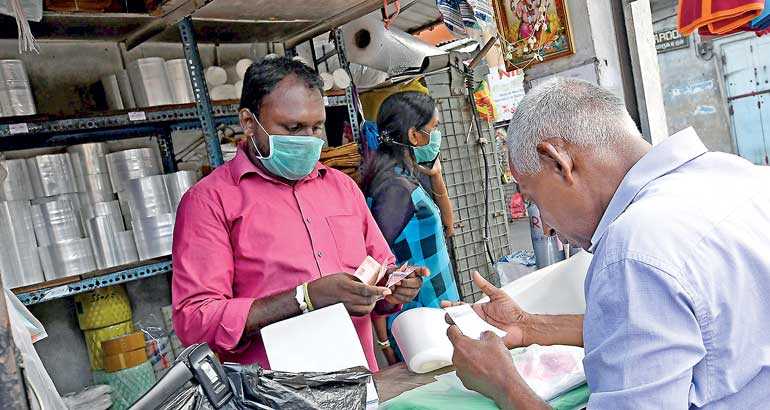Saturday Feb 22, 2025
Saturday Feb 22, 2025
Tuesday, 9 June 2020 00:00 - - {{hitsCtrl.values.hits}}

The biggest challenge for any business now is ‘continuity’ – Pic by Shehan Gunasekara
How soon will the crisis end? How should I resume with things post lockdown? Will everything be the same as it was before the lockdown? Where will I be in six months or one year or 10 years from now? We all seek answers, isn’t it?
Pancham Banerji, seasoned digital and media entrepreneur and CEO, AdEngage and AdEngage Studios, an integrated digital communication and web-series production company in India, shares his views and analysis on doing business and marketing post lockdown.

Experts say that there is a high possibility that we might be tied to our homes for months until we find a vaccine. Nobody knows how long it will last and how soon the world will bounce back. The biggest challenge for any business now is ‘continuity’.
Some businesses cannot cut operating costs but have to keep their nose above the water. We all know it’s a phase and it will pass and hopefully, we all will come out stronger. Pancham rightly says, “Performance marketing along with an integrated digital communication strategy will be the need of the hour. Technological and process changes are necessary to make sure brands survive the present economic slowdown. This is the time to sit back and re-think what can be improved.”
Pancham foresees two major shifts in customer buying behaviour:
Pancham adds, “As people opt to remain in their homes, online delivery services are likely to see an increase in demand; because of their ability to provide products and services directly to the consumer’s doorstep. Don’t be surprised if you find hundreds of start-ups entering the delivery business in the next 10-20 months.”
Businesses post-coronavirus may look like this, mentions Pancham:
1. Contactless interfaces and interactions
With the increase in people wanting to limit what they touch, post-COVID-19 we will see the reduction in usage of the touch screen. More of contactless payment, voice and machine vision interfaces will limit the amount of physical contact. This is a great opportunity for tech companies. There is a big possibility that tech start-ups might surprise big tech giants both in terms of technology, market share, and revenue.
2. Strengthened digital infrastructure
COVID-19 has taught all of us how to live life with limited resources. So, shortly soon professionals will try to avoid traveling for attending board meetings, conferences, events, and outdoor gatherings as much as possible. Video calls or zoom meetings might soon become the new normal in corporates. Many will start conducting virtual consultation or online classes. Hence, it is necessary to strengthen your digital infrastructure at home so you can always have the feeling of working from the office.
3. Better monitoring using IoT and big data
There would be better apps for effectively monitoring future pandemics by using the internet, technology, and big data. GPS data could track where exposed people have been and who they have interacted with.
4. Small shops will go online
After COVID-19, even small businesses will switch to online selling to stay competitive. We can expect a better improvement in the logistics and delivery systems to accommodate surges in demand.
5. Reliance on robots
Robots aren’t susceptible to viruses, hence can be used during such crises. Businesses will rely on robots for delivery or to keep a factory running.
6. Steep rise in digital events
After COVID-19, event organisers will figure out ways the digital aspects can complement in-person events.
7. Disaster insurance policy
You might never know there could be a rise in companies dealing with insurance coverage for crises such as business closures or trip cancellations, manage expenses, etc.
Thinking about a few possibilities of a quick recovery, Pancham says;
Here are some strategies businesses must adopt to overcome situations post-COVID-19:
1. Protect cash flow
Cash flow is the life of any business and for its optimum business health, continuous inflow and outflow are essential. It is necessary to implement strategies to keep the cash flowing by increasing sales and trimming unnecessary expenses.
2. Reduce inventory cost
The e-commerce industry can try to reduce inventory costs without sacrificing quality. Check if it’s possible to source from somewhere else at a better price, opt for drop-shipping, or eliminate shipping and warehousing costs.
3. Focus on core competencies
Drop the extras and focus on what is best that’s most profitable for your business.
4. Win competitors’ customers
Research your competitor’s strategy and see how you can outsmart them. Think of what you can do to entice their customers into becoming your customers.
5. Keep your current customers happy
Keeping your current customers happy will work in your favour. They can give you many more sales opportunities and also increase your sales through word-of-mouth marketing without incurring the costs of finding new customers.
6. Avoid cost cutting on marketing
Many small businesses make the mistake of cutting their marketing budget or eliminate it at such crucial times when it’s much needed.
“The steep increase in time spent online and low advertising spend by large corporations may lead to low bids for online advertising across all major auction-based platforms like Google and Facebook. This will help companies get more impressions at less cost. This is a perfect time to get more impact out of your regular marketing spend,” says Pancham.
7. Crisis management policy
Businesses have to be prepared for the worst-case scenario. It also has to be prepared for lines of credit in place, supply chain alternatives, and more. Service businesses will continue to operate in some way, other companies, such as restaurants, multiplex theatres, and travel will have to think of “Plan B” to manage staff and cash flows. Switching the business model during such crises or finding an alternative business model will be necessary.
This is a takeaway for all of us. John F. Kennedy says, “The word ‘crisis’ is composed of two characters – Danger and Opportunity.” Now, it’s your choice!
“Looking at the present trend, the in-home online and TV activity will increase and advertisers can reach their target audience during this time by investing more heavily in television (traditional or Connected TV), digital, and direct mail advertising over out-of-home advertising and this trend might continue for this year,” says Banerji.
Conclusion
Rather than taking a sigh of relief and returning to normal routines when the crisis subsides, it’s mandatory to put-in efforts to improve businesses for the future. Why not follow RoberTew, “The struggle you’re in today is developing the strength you need tomorrow.”
It says that nothing will make businesses 100% recession-proof, but implementing some preventive measures and analysing ways to improve can surely ensure that businesses survive tough times. It’s important to remember that setbacks, failures, and crises are a part of life. It all comes down to our ability to persevere through even the toughest adversity without ever giving up. Think every possible way, analyse your customer needs, keep yourself updated with the current affairs and competitive scores, and also make sure you don’t miss on the best tool of this digital era.
Pancham adds: “Compassion in advertising will be critical and will ensure brands remain in the positive light which will in-fact help in re-branding a brand. Therefore, brands that have lost clients in the past because of poor service can look forward to making a comeback into the game.”
The present situation is not the final destination; the best is yet to come. Sometimes the world needs a crisis to turn challenges into opportunities. Hopefully, we will use this time of crisis to rebuild and come back with a bang! #TogetherWeWillWin.
Discover Kapruka, the leading online shopping platform in Sri Lanka, where you can conveniently send Gifts and Flowers to your loved ones for any event including Valentine ’s Day. Explore a wide range of popular Shopping Categories on Kapruka, including Toys, Groceries, Electronics, Birthday Cakes, Fruits, Chocolates, Flower Bouquets, Clothing, Watches, Lingerie, Gift Sets and Jewellery. Also if you’re interested in selling with Kapruka, Partner Central by Kapruka is the best solution to start with. Moreover, through Kapruka Global Shop, you can also enjoy the convenience of purchasing products from renowned platforms like Amazon and eBay and have them delivered to Sri Lanka.
Discover Kapruka, the leading online shopping platform in Sri Lanka, where you can conveniently send Gifts and Flowers to your loved ones for any event including Valentine ’s Day. Explore a wide range of popular Shopping Categories on Kapruka, including Toys, Groceries, Electronics, Birthday Cakes, Fruits, Chocolates, Flower Bouquets, Clothing, Watches, Lingerie, Gift Sets and Jewellery. Also if you’re interested in selling with Kapruka, Partner Central by Kapruka is the best solution to start with. Moreover, through Kapruka Global Shop, you can also enjoy the convenience of purchasing products from renowned platforms like Amazon and eBay and have them delivered to Sri Lanka.